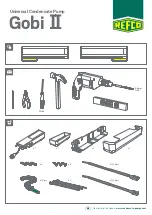
6
•
Frequent washing of the cabinet, fan blade and coil with fresh water will remove
most of the salt or other contaminants that build up on the unit.
•
Regular cleaning and waxing of the cabinet with an automobile polish will pro-
vide some protection.
•
A liquid cleaner may be used several times a year to remove matter that will not
wash off with water.
Several different types of protective coatings are offered in some areas. These
coatings may provide some benefit, but the effectiveness of such coating materials
cannot be verified by the equipment manufacturer.
LOCATING UNIT
CONDENSER LOCATION
Consult local and national building codes and ordinances for special installation
requirements. Following location information will provide longer life and simplified
servicing of the outdoor condenser.
NOTE:
These units must be installed outdoors. No ductwork can be attached, or
other modifications made, to the discharge grille. Modifications will affect perform-
ance or operation.
OPERATIONAL ISSUES
•
IMPORTANT:
Locate the condenser in a manner that will not prevent, impair or
compromise the performance of other equipment horizontally installed in prox-
imity to the unit. Maintain all required minimum distances to gas and electric
meters, dryer vents, exhaust and inlet openings. In the absence of National
Codes, or manaufacturers’ recommendations, local code recommendations and
requirements will take presidence.
•
Refrigerant piping and wiring should be properly sized and kept as short as pos-
sible to avoid capacity losses and increased operating costs.
•
Locate the condenser where water run off will not create a problem with the
equipment. Position the unit away from the drip edge of the roof whenever pos-
sible. Units are weatherized, but can be affected by the following:
o Water pouring into the unit from the junction of rooflines, without protective
guttering. Large volumes of water entering the condenser while in operation
can impact fan blade or motor life, and coil damage may occur to a heat
pump if moisture cannot drain from the unit under freezing conditions.
•
Closely follow clearance recommendations on Page 3.
o 24” to the service panel access
o 60” above condenser fan discharge (unit top) to prevent recirculation
o 6” to condenser coil grille air inlets (per condenser).
FOR CONDENSERS WITH SPACE LIMITATIONS
In the event that a space limitation exists, we will permit the following clearances:
Single Unit Applications:
Clearances below 6 inches will reduce unit capacity and
efficiency. Do not reduce the 60-inch discharge, or the 24-inch service clearances.
Multiple Unit Applications:
When multiple condenser grille sides are aligned, a 6-
inch per unit clearance is recommended, for a total of 12" between two units. Two
combined clearances below 12 inches will reduce capacity and efficiency. Do not
reduce the 60-inch discharge, or 24-inch service, clearances.
•
Do not obstruct the bottom drain opening in the condenser base pan. It is
essential to provide defrost condensate drainage to prevent possible refreezing
of the condensation. Provide a base pad for mounting the unit, which is slightly
pitched away from the structure. Route condensate off the base pad to an area
which will not become slippery and result in personal injury.
!
WARNING
DISCONNECT
ALL
POWER
TO
UNIT
BEFORE
STARTING
MAINTENANCE. FAILURE TO DO SO CAN CAUSE ELECTRICAL SHOCK
RESULTING IN SEVERE PERSONAL INJURY OR DEATH.
Summary of Contents for 018J*Z
Page 24: ...24 FIGURE 4 SINGLE PHASE WIRING DIAGRAM ...
Page 25: ...25 FIGURE 5 THREE PHASE WIRING DIAGRAM C D Y VOLTAGES ...
Page 26: ...26 FIGURE 6 ...
Page 27: ...27 ...
Page 28: ...28 CM 0908 ...







































